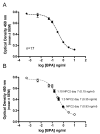Bisphenol A is released from polycarbonate drinking bottles and mimics the neurotoxic actions of estrogen in developing cerebellar neurons
- PMID: 18155859
- PMCID: PMC2254523
- DOI: 10.1016/j.toxlet.2007.11.001
Bisphenol A is released from polycarbonate drinking bottles and mimics the neurotoxic actions of estrogen in developing cerebellar neurons
Abstract
The impact of endocrine disrupting chemical (EDC) exposure on human health is receiving increasingly focused attention. The prototypical EDC bisphenol A (BPA) is an estrogenic high-production chemical used primarily as a monomer for the production of polycarbonate and epoxy resins. It is now well established that there is ubiquitous human exposure to BPA. In the general population, exposure to BPA occurs mainly by consumption of contaminated foods and beverages that have contacted epoxy resins or polycarbonate plastics. To test the hypothesis that bioactive BPA was released from polycarbonate bottles used for consumption of water and other beverages, we evaluated whether BPA migrated into water stored in new or used high-quality polycarbonate bottles used by consumers. Using a sensitive and quantitative competitive enzyme-linked immunosorbent assay, BPA was found to migrate from polycarbonate water bottles at rates ranging from 0.20 ng/h to 0.79 ng/h. At room temperature the migration of BPA was independent of whether or not the bottle had been previously used. Exposure to boiling water (100 degrees C) increased the rate of BPA migration by up to 55-fold. The estrogenic bioactivity of the BPA-like immunoreactivity released into the water samples was confirmed using an in vitro assay of rapid estrogen signaling and neurotoxicity in developing cerebellar neurons. The amounts of BPA found to migrate from polycarbonate drinking bottles should be considered as a contributing source to the total "EDC-burden" to which some individuals are exposed.
Figures



References
-
- Belcher SM, Le HH, Spurling L, Wong JK. Rapid estrogenic regulation of extracellular signal- regulated kinase 1/2 signaling in cerebellar granule cells involves a G protein- and protein kinase A-dependent mechanism and intracellular activation of protein phosphatase 2A. Endocrinology. 2005;146:5397–406. - PubMed
-
- Biles JE, McNeal TP, Begley TH, Hollifield HC. Determination of Bisphenol-A in Reusable Polycarbonate Food-Contact Plastics and Migration to Food-Simulating Liquids. J. Agric. Food Chem. 1997;45:3541–3544.
-
- Brede C, Fjeldal P, Skjevrak I, Herikstad H. Increased migration levels of bisphenol A from polycarbonate baby bottles after dishwashing, boiling and brushing. Food Additives & Contaminants. 2003;20:684–689. - PubMed
-
- CERHR Interm NTP-CERHR report on the reproductive and developmental toxicity of bisphenol A. 2007. http://cerhr.niehs.nih.gov/chemicals/bisphenol/BPA_Interim_DraftRpt.pdf. - PubMed
Publication types
MeSH terms
Substances
Grants and funding
LinkOut - more resources
Full Text Sources

